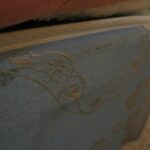As pet owners, we strive to provide the best possible care for our furry companions. One aspect of this care is ensuring that their bedding remains clean and comfortable. A dog bed is a cozy space where our pets can relax and feel at ease, but over time, it can accumulate dirt, debris, and unpleasant odors.
To maintain the hygiene and comfort of your dog’s bed, it is crucial to wash it regularly. However, washing a dog bed may seem like a daunting task for some pet owners. In this article, we will outline four easy steps to help you wash your dog’s bed effectively. By following these simple steps, you can ensure that your pet’s sleeping area remains fresh and clean, promoting their overall health and well-being.
Importance Of Washing Your Dog’s Bed
A dog bed is like a haven where your furry friend can rest and recharge. However, it’s easy to forget the importance of keeping it clean. The benefits of cleanliness are tremendous; not only does it eliminate odors and dirt, but it also ensures that your dog stays healthy. A dirty dog bed can lead to various health risks, such as skin irritations, infections, and even parasites.
Skin irritations are one of the most common effects of dirty dog beds. Your pup’s skin is sensitive and prone to rashes caused by bacteria buildup on his bed. Additionally, if you don’t wash your dog’s bed regularly, it may become a breeding ground for fleas and ticks. These pesky insects can cause severe discomfort to your furry companion and spread diseases such as Lyme disease.
Moreover, an uncleaned dog bed can lead to bacterial infections that can affect both you and your pet negatively. Bacteria thrive in warm environments, making your dog’s bed the perfect place for them to grow and multiply. Therefore, washing your dog’s bed regularly is necessary for maintaining hygiene standards at home. In the next section, we will explore different types of dog beds that require unique cleaning methods to ensure their longevity and cleanliness.
Types Of Dog Beds
Nest beds are great for dogs who like to feel cozy and surrounded. Orthopedic beds provide extra support to help relieve joint pain and discomfort. Pillow beds are ideal for dogs who enjoy a soft surface for sleeping. Donut beds offer a combination of comfort and support, making them a popular choice for many owners.
Nest Beds
Dog beds come in various types and designs, each with its unique features that cater to different dog breeds and sizes. One of the most popular types is the nest bed, which provides a cozy and comfortable place for dogs to sleep. If you are looking for a bed that can provide your furry friend with maximum warmth and comfort, then a nest bed might be the perfect choice.
Nest beds come in different sizes, making them ideal for all dog breeds. From small Chihuahuas to large Golden Retrievers, there is always a nest bed size that will fit your pup. Additionally, these beds have high sides that create a sense of security and privacy for dogs who love to burrow or snuggle up while sleeping.
The best nest bed design features include soft padding and orthopedic foam for maximum comfort. The cover material should also be durable, easy to clean, and resistant to water or stains. When choosing a nest bed, it’s essential to consider your dog’s sleeping habits and preferences so that you can get the right size and design that meets their needs. By providing your furry friend with a comfortable space to rest after an active day, you are promoting their overall health and well-being.
Orthopedic Beds
Moving on to another type of dog bed that is gaining popularity among pet owners is the orthopedic bed. This bed is designed to provide maximum support and comfort for dogs with joint pain or arthritis. Memory foam is the main feature of an orthopedic bed, which conforms to the dog’s body shape, relieving pressure from their joints.
Orthopedic beds come in different sizes, making them ideal for all dog breeds, especially senior dogs who need extra support. These beds also have waterproof coverings that prevent moisture from penetrating the foam and causing mold or bacterial growth. The covers are typically removable and machine washable, making it easy to clean and maintain.
When choosing an orthopedic bed for your furry friend, consider their weight and size to ensure that they get enough support from the memory foam. A good quality orthopedic bed should also have a non-slip bottom to prevent movement while your pet is getting in or out of the bed. By providing your dog with an orthopedic bed, you are not only giving them a comfortable place to rest but also promoting their overall health and well-being by reducing joint pain and discomfort.
In conclusion, there are various types of dog beds available in the market, each with its unique features that cater to different needs. Whether it’s a nest bed or an orthopedic bed, it’s essential to choose a design that meets your furry friend’s sleeping habits and preferences while providing maximum comfort and support. Investing in a good quality dog bed can benefit both you and your pet by ensuring they get enough restful sleep needed for their physical and mental health.
Materials Used In Dog Beds
After discussing the various types of dog beds, it is important to delve into the materials used in their construction. The type of material used can greatly affect the comfort and durability of the bed, as well as its overall maintenance.
Common materials used in dog beds include foam, polyester fiberfill, and memory foam. Foam beds are often less expensive but may not provide adequate support for dogs with joint issues. Polyester fiberfill is a popular choice due to its affordability and washability, but may flatten over time. Memory foam is a more expensive option that molds to a dog’s body for maximum comfort and support.
Proper cleaning and maintenance of your dog’s bed will extend its lifespan and ensure your pet’s health and comfort. Depending on the material of the bed, different cleaning methods may be necessary. For example, foam beds can be spot-cleaned with mild soap and water while polyester fiberfill beds can be thrown in the washing machine on a gentle cycle.
To further prolong your dog’s bed life, consider investing in protective covers or rotating between multiple beds to reduce wear and tear. Regularly inspecting your pet’s bedding for signs of damage or wear will also help prevent potential health hazards such as bacteria growth or mold accumulation.
As important as knowing how to clean your pet’s bed is knowing how often it should be done. The frequency at which you should wash your dog’s bed depends on factors such as shedding, outdoor exposure, and overall cleanliness habits. A good rule of thumb is to wash your pet’s bedding at least once every two weeks or more frequently if needed. By providing clean and comfortable bedding for your furry friend, you are promoting their health and happiness.
Frequency Of Washing Your Dog’s Bed
Just like how we need to wash our bed sheets regularly, the same goes for our furry companions’ beds. After all, dogs tend to spend a lot of time lounging and sleeping on their beds. But how often should you wash your dog’s bed? The answer depends on several factors such as your dog’s lifestyle, habits, and health.
For most dogs, washing their bed every two weeks is ideal. However, if your dog has allergies or skin conditions, it’s best to wash their bed weekly or as recommended by your veterinarian. Dogs that spend a lot of time outdoors and get dirty easily may also require more frequent washing.
To maintain a healthy living environment for your pet and household, it’s crucial to establish a regular washing routine for your dog’s bed. This not only helps keep their bed clean and free from bacteria and allergens but also prolongs its lifespan.
In the next section, we will discuss the preparation process for washing your dog’s bed to ensure that you do it right without damaging the material or compromising its quality.
Preparation For Washing Your Dog’s Bed
As we have learned, washing your dog’s bed regularly is essential to maintain a clean and healthy environment for your furry friend. Now that we know how often to wash the bed, let’s move on to preparing for the actual washing process.
Preparing the space where you will be washing your dog’s bed is crucial. You want to ensure that the area you choose has proper ventilation and enough space to accommodate the size of your pet’s bed. It’s also important to have all the necessary equipment and cleaning supplies ready before starting. Lastly, make sure that you are wearing gloves and old clothes that you don’t mind getting dirty.
When it comes to selecting the best detergents for washing your dog’s bed, it’s essential to choose a mild detergent that won’t irritate their skin or cause an allergic reaction. Some good options include baby laundry detergents or those specifically designed for pets. Avoid using fabric softeners or bleach as they can damage the fabric and cause irritation to your pet’s skin.
Now that we’ve covered how to prepare for washing your dog’s bed let’s move on to step 1: Remove excess loose dirt and hair. By following these simple steps, you’ll be able to keep your furry friend comfortable and healthy while ensuring their bedding stays clean and fresh!
Step 1: Remove Excess Loose Dirt And Hair
Firstly, before washing your dog bed, it is essential to remove any excess loose dirt and hair. This will make the cleaning process much more manageable and effective. To do this, one can use a vacuum cleaner with a hose attachment to suck up all the unwanted debris from the surface of the bed. Alternatively, one can use a lint roller or a sticky tape to pick up hair and fur.
Once you have removed as much loose dirt and hair as possible, it’s time to move onto the next step. Before washing your dog’s bed, it’s a good idea to pretreat any stains or odors that may be present on the fabric. This will ensure that they are fully removed during the washing process. There are various pet-friendly cleaning products available in stores that can help with this task.
Another option for pretreating stains and odors is to use baking soda. This household item has natural deodorizing properties that can help eliminate unpleasant smells from your dog bed. Simply sprinkle baking soda over the surface of the bed and let it sit for a few hours before vacuuming it up again. This will not only help with odor elimination but also serve as an additional measure for removing loose dirt and hair from the bed.
Moving onto step 2, after removing any excess loose dirt and hair from your dog bed, you should now focus on pretreating any stains or odors that may be present on the fabric. There are various methods of doing this effectively, including using pet-friendly cleaning products or utilizing household items such as baking soda. By taking these steps before washing your dog’s bed, you can ensure that it comes out looking fresh and clean every time!
Step 2: Pretreat Stains And Odors
Stains can be pretreated with detergent, vinegar, baking soda, rubbing alcohol, and enzyme cleaner. Odors can be treated by brushing, vacuuming, rubbing, blotting, and spraying. It is important to spot-test any of these chemicals on the dog bed to determine if it is safe to use. Finally, any of these treatments should be done with care and according to instructions.
Stains
When washing a dog bed, it is common to encounter stains that may be difficult to remove. Removing stubborn stains can be challenging, but it is essential to ensure the bed is clean and free from any unwanted odor. Using natural stain removers can help eliminate tough stains without causing any harm or irritation to your pet.
One of the most effective natural stain removers is vinegar. Dilute white vinegar with water and apply it to the stained area. Allow the solution to sit for a few minutes before washing as usual. Another option for removing stubborn stains is baking soda. Apply baking soda directly to the affected area and let it sit for a few hours before vacuuming it off.
It’s important to avoid using harsh chemicals when pretreating stains on your dog bed as they may cause harm or irritation to your pet’s skin. As a responsible pet owner, you should always prioritize your pet’s health and safety when selecting cleaning products. By using natural stain removers such as vinegar and baking soda, you can effectively remove stubborn stains while keeping your furry friend safe and healthy.
Odors
Removing odors is an essential step in cleaning your dog’s bed. Odors can linger and cause discomfort to both you and your pet. It’s important to address any unpleasant smells before washing the bed. Dealing with stains is not enough; pet owners must also tackle the source of the odor to ensure that their furry companions have a clean and fresh-smelling place to rest.
One way of removing odors from a dog bed is by using baking soda. Sprinkle baking soda generously on the bed, making sure to cover all areas, including seams and corners. Let it sit for several hours or overnight, then vacuum it off thoroughly. Baking soda is a natural odor absorber that can eliminate unwanted smells without causing any harm or irritation to your pet.
Another effective way of removing odors is by using essential oils. Dilute a few drops of your preferred essential oil in water and apply it to the bed using a spray bottle. Allow the solution to dry naturally before washing as usual. Essential oils such as lavender, peppermint, and lemon are known for their antibacterial properties and pleasant scents, making them great choices for keeping your dog’s bed smelling fresh.
By following these tips for removing odors from a dog bed, you can ensure that your furry friend has a clean and comfortable place to sleep. Remember that regular cleaning is crucial in maintaining good hygiene for both you and your pet. With proper care, your dog’s bed will stay fresh-smelling and free from any unwanted stains or smells.
Step 3: Choose The Right Washing Method
Choosing the right washing method is essential to ensure that your dog’s bed is clean and fresh-smelling. There are different washing methods available, and you should choose the one that is best for your pet’s bed material. Before proceeding, check the care label on your dog’s bed to see if there are specific cleaning instructions.
Firstly, hand-washing is recommended for dog beds made of delicate fabrics or have a filling that clumps up in a washing machine. Use lukewarm water and a mild laundry detergent to avoid damaging the fabric or filling. Soak the bed for 15-20 minutes, then gently scrub any stains or dirt away before rinsing thoroughly.
Secondly, machine-washing is suitable for most dog beds, but be sure to read the care label before loading it into the machine. Choose a gentle cycle with cold water and use a mild detergent. It’s best to wash only one dog bed at a time to prevent tangling and damage.
Lastly, drying techniques also vary depending on the type of dog bed you have. Air-drying is suitable for delicate fabrics such as silk or wool, while machine-drying may be used for synthetic materials like polyester or nylon. If using a dryer, choose low heat settings and add tennis balls or dryer balls to prevent clumping.
- Keep in mind that harsh detergents can irritate your pet’s skin.
- Avoid using fabric softeners as they can reduce absorbency.
- Always remove excess hair from the bed before washing.
- Regular cleaning extends the life of your pet’s bed.
The next step in washing your dog’s bed involves using a washing machine.
Washing A Dog Bed In A Washing Machine
After choosing the right washing method, it’s time to wash your dog bed. One common way of washing a dog bed is through the use of a washing machine. Using a washing machine can be an efficient and effective way of cleaning your dog bed, especially for large and bulky beds.
However, some pet owners may prefer alternative washing methods such as hand washing or spot cleaning. Hand washing may take more time and effort but can be gentler on the fabric of the bed while ensuring that all parts are thoroughly cleaned. Spot cleaning, on the other hand, can be useful for minor stains or messes that do not require a full wash.
If you choose to use a washing machine, avoid using fabric softener as this can damage the fabric and reduce its water-resistant properties. Instead, opt for a mild detergent suitable for pet beds. It’s also recommended to air dry or tumble dry on low heat to prevent any damage to the bed’s filling or shape. If you decide to hand wash or spot clean your dog bed, make sure to follow similar guidelines in using appropriate cleaning agents and drying methods.
Transition Sentence: Now that we’ve discussed using a washing machine to clean your dog bed let’s move on to another alternative – hand washing a dog bed.
Hand Washing A Dog Bed
- Preparing a dog bed for washing involves removing any dirt, debris, and other materials from the bed.
- Washing the bed requires selecting a detergent that is suitable for pet bedding, and pre-treating any stains before washing.
- Once pre-treated, the bed should be washed in a washing machine on a gentle cycle with cold water.
- After washing, the bed should be dried in a dryer on a low-heat setting or air-dried outdoors.
Preparing The Bed
As pet owners, we want nothing but the best for our furry friends. One of the ways we can show our love and care for them is by providing a clean and comfortable bed to sleep in. However, over time, a dog bed can accumulate dirt, fur, and odors, making it necessary to wash it regularly. To ensure that your dog’s bed is properly cleaned and maintained, there are four essential steps you need to follow.
The first step in hand washing a dog bed is to prepare the bedding. This involves choosing bedding that is appropriate for your dog’s needs and preferences. Consider factors such as size, material, thickness, and durability when selecting the bedding. You may also want to invest in bedding accessories such as pillows or blankets for added comfort. Additionally, keep up with current dog bedding trends and styling tips to ensure your pet has a stylish and cozy sleeping space.
Once you have chosen the right bedding for your furry friend’s bed, it’s time to prepare it for washing. Remove any loose fur or debris from the surface of the bed using a lint roller or vacuum cleaner attachment. Next, check the care label on the bed to determine if it is machine washable or if hand washing is required. If hand washing is recommended, fill a large sink or bathtub with warm water and add a mild detergent specifically designed for pet bedding. Submerge the bed in the soapy water and gently agitate it with your hands to dislodge any dirt or stains.
Washing The Bed
Maintaining a clean and comfortable sleeping space for our furry friends is essential to their overall well-being. While it may seem like a daunting task, hand washing a dog bed can be an effective way to ensure that your pet’s sleeping space is free from dirt, fur, and odors. The process of hand washing involves four essential steps: preparing the bedding, removing loose fur or debris, using cleaning solutions, and drying techniques.
One crucial step in hand washing a dog bed is the use of appropriate cleaning solutions. When selecting a detergent specifically designed for pet bedding, it’s important to avoid harsh chemicals that may cause skin irritation or respiratory problems for your furry friend. Instead, opt for mild detergents that are gentle on their skin and effectively remove odor-causing bacteria. Additionally, consider using natural cleaning solutions such as vinegar or baking soda to disinfect and deodorize the bedding.
After thoroughly cleaning the dog bed with soap and water, it’s time to dry it properly to avoid mold growth or damage to the fabric. Avoid using high heat settings when machine-drying as this may shrink or damage the bedding material. Instead, air-dry the bed by placing it in a well-ventilated area or hanging it outside if weather permits. Alternatively, you can use a fan or hairdryer set on low heat to speed up the drying process. By following these simple steps in hand washing a dog bed, you can maintain a clean and comfortable sleeping space for your furry friend while ensuring their overall health and well-being.
Drying Your Dog’s Bed
After washing your dog’s bed, it’s important to dry it properly to prevent mold and mildew growth. There are two main methods for drying a dog bed: air drying and using a dryer. The method you choose will depend on the material of the bed.
Natural materials like cotton or wool should be air-dried to prevent shrinkage or damage. Hang the bed outside on a clothesline or indoor rack, making sure it’s not in direct sunlight or heat source. Synthetic materials like polyester or nylon can be dried in the dryer on a low heat setting. Be sure to check the care label for any specific instructions.
It’s important to note that some dog beds may require both methods for proper drying. For example, if your dog’s bed has a removable cover made of natural materials, you may need to air dry it while putting the synthetic filling in the dryer. Regardless of which method you use, make sure the bed is completely dry before returning it to your furry friend’s sleeping area.
Step 4: Finishing Touches
- Once the dog bed has been thoroughly washed, it is important to ensure that it is properly air-dried before any other processes take place.
- Air-drying can be done either indoors or outdoors, depending on the weather and the preference of the owner.
- Vacuuming the dog bed after it has been air-dried is an effective way to remove any pet hair or dirt that may have been left behind during the washing process.
- Vacuuming should be done using a gentle brush attachment and should be completed before the bed is put back for use.
Air-Drying
When it comes to washing your dog’s bed, ensuring that it is completely dry before use is crucial. Air-drying is the best way to achieve this, as it avoids any damage that heat from a dryer could cause to the bed’s material. Here are some tips for speeding up air drying and the best materials to use.
Firstly, consider placing the bed in an area with good ventilation and air flow. This could be outside on a sunny day or inside near an open window or fan. Using a clean towel to absorb excess moisture can also help speed up the process. Another option is using a pet hair dryer on a low heat setting, but make sure to keep it at a safe distance from the bed.
Secondly, choosing the right materials for air-drying can make all the difference. Opt for fabrics that are lightweight and breathable, such as cotton or linen. Avoid using heavy blankets or towels that could trap moisture and slow down drying time. Additionally, ensure that the bed is completely disassembled before air-drying to allow each component to dry evenly.
In conclusion, air-drying your dog’s bed is essential for maintaining its quality and cleanliness after washing. By following these tips for speeding up air drying and selecting appropriate materials, your pet’s bed will be ready for use in no time.
Vacuuming
Moving on to Step 4: Finishing Touches, one important aspect of maintaining a clean and comfortable sleeping area for your furry friend is vacuuming. Even if you wash your dog’s bed regularly, pet hair can still accumulate and cause discomfort or allergic reactions. Vacuuming is an effective way to remove any remaining hair or debris that may have been missed during the washing process.
When it comes to vacuuming your dog’s bed, there are a few things to keep in mind. Firstly, make sure that the bed is completely dry before starting. Using a vacuum on wet or damp material can damage the fabric and create mold or mildew growth. Secondly, opt for a vacuum with strong suction power and attachments specifically designed for pet hair removal. These attachments usually have rubberized bristles that attract and lift hair from the surface.
To effectively remove pet hair from your dog’s bed, start by using the upholstery attachment to cover all surfaces of the bed. Pay extra attention to seams, corners, and edges where hair tends to accumulate. For stubborn spots, use a lint roller or masking tape to pick up any remaining hairs or debris. Finally, dispose of any collected debris in a sealed bag and sanitize your vacuum attachments after use.
In summary, vacuuming is an essential step in keeping your dog’s bed clean and free from pet hair accumulation. Remember to use appropriate tools and techniques when vacuuming, ensuring that the bed is completely dry before starting and disposing of any debris properly after use.
Maintaining Your Dog’s Bed Between Washes
Dog bed hygiene is an important aspect of pet care that should be properly maintained between washes. Regular cleaning and maintenance help eliminate bacteria and prevent the buildup of dirt and hair on your dog’s bed. To keep your dog’s bed clean, it is essential to vacuum it regularly. Vacuuming helps remove hair, dirt, and dust mites that can cause respiratory problems in your dog.
Odor control tips are also crucial when it comes to maintaining your dog’s bed hygiene. Using baking soda or a fabric freshener spray can help keep the bed smelling fresh and clean between washes. It is important to avoid using strong chemical-based cleaners as they can irritate your furry friend’s skin and cause allergies.
Another way to maintain your dog’s bed hygiene is by using a waterproof liner or cover. This can protect the bed from spills, accidents, and other stains. Additionally, you can rotate the cushion inside the cover every week to ensure even wear and tear.
- A clean dog bed provides a comfortable sleeping environment for your furry friend.
- Proper maintenance of your dog’s bed ensures longevity.
- Maintaining good hygiene practices on your dog’s bedding will reduce any unpleasant odors in the house.
In conclusion, taking care of your pet includes providing them with a clean sleeping area that is free from bacteria, dirt, and bad odor. With proper maintenance practices such as regular vacuuming, odor control tips, and using waterproof covers or liners, you can ensure that your furry friend enjoys a comfortable sleep while staying healthy. In the subsequent section about common mistakes to avoid when washing your dog’s bed, we will discuss things you need to be aware of when cleaning up after your furry friend.
Common Mistakes To Avoid When Washing Your Dog’s Bed
Even though washing your dog’s bed is important, there are common mistakes that pet owners make. One of the most common mistakes is overloading the washing machine with too many items or adding too much detergent. Overloading can cause the bed to not receive a thorough cleaning and using too much detergent can leave residue on the bed, which can irritate your dog’s skin.
To keep your dog’s bed clean between washes, regular vacuuming and spot cleaning are crucial. Vacuuming helps remove hair, dirt, and debris that accumulates on the bed, while spot cleaning targets any specific stains or smells. These tasks don’t have to be time-consuming; just a few minutes each week can make a big difference in keeping your dog’s bed fresh and clean.
By avoiding common mistakes and implementing simple tips for keeping your dog’s bed clean, you’ll ensure that your furry friend has a comfortable sleeping space that promotes good health and hygiene. In the next section, we’ll discuss some benefits of regularly cleaning your dog’s bed and how it contributes to overall pet wellness.
Benefits Of A Clean Dog Bed
After avoiding common mistakes in washing your dog’s bed, it is essential to understand the benefits of keeping the bed clean. A clean dog bed can prevent harmful bacteria and parasites from thriving, reducing the risk of infections or illnesses that may affect both your pet’s health and yours. Keeping a clean dog bed can also help maintain a more hygienic living environment for your furry friend.
Regularly washing your dog’s bed is one way to keep it clean, but there are other ways to ensure its cleanliness. For instance, vacuuming the bed frequently can remove hair, dirt, and debris that may accumulate on the surface or in between crevices. Additionally, using a pet-friendly disinfectant solution can kill microorganisms that may be present on the bed.
Apart from promoting hygiene and preventing diseases, keeping your dog’s bed clean can also improve their overall well-being. A clean and comfortable sleeping surface can improve their sleep quality, reduce stress levels and promote faster healing from injuries or illnesses. Maintaining a clean dog bed is an essential aspect of responsible pet ownership that every pet parent should prioritize.
Ensuring that your furry friend has a healthy living environment is crucial for their physical and emotional well-being. Incorporating regular cleaning routines such as washing their bedding, vacuuming their sleeping area, and using disinfectants are some of the ways to keep your dog healthy. By prioritizing cleanliness in your pet’s living space, you’re also making sure they have a comfortable place to rest after long walks or playtime sessions.
Conclusion
Maintaining a clean dog bed is essential for the health and well-being of your furry friend. In this article, we have discussed the importance of washing your dog’s bed and provided a step-by-step guide to make the process easier.
We first explored the different types of dog beds available in the market and the materials used in their construction. We then talked about how often you should wash your dog’s bed and how to prepare it for cleaning. Our four-step guide covered everything from pre-treating stains to drying and fluffing the bed.
Finally, we looked at common mistakes to avoid when washing your dog’s bed and discussed tips for maintaining its cleanliness between washes. A clean dog bed not only ensures good hygiene but also promotes better sleep quality for your pet. By following our guide, you can help keep your furry companion happy and healthy. Remember, a little effort goes a long way in ensuring that your four-legged friend has a comfortable place to rest!
Image Credits
- “Washable Dog bed covers” by DesignFolly.com (featured)





























